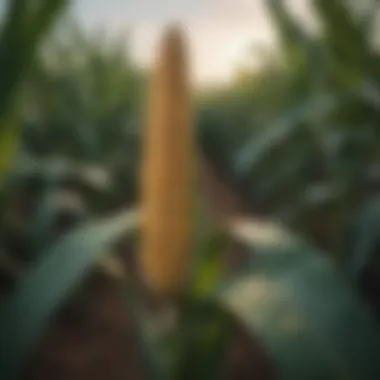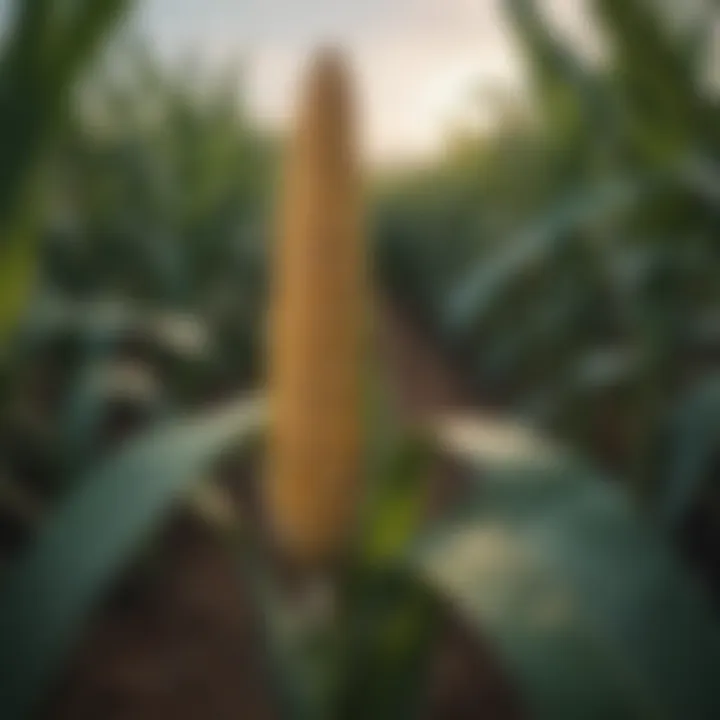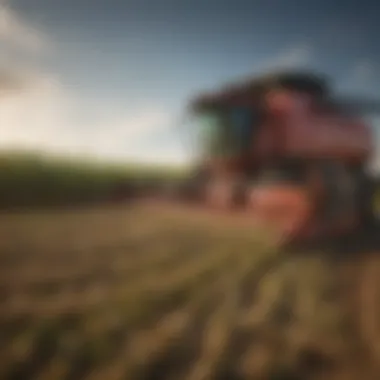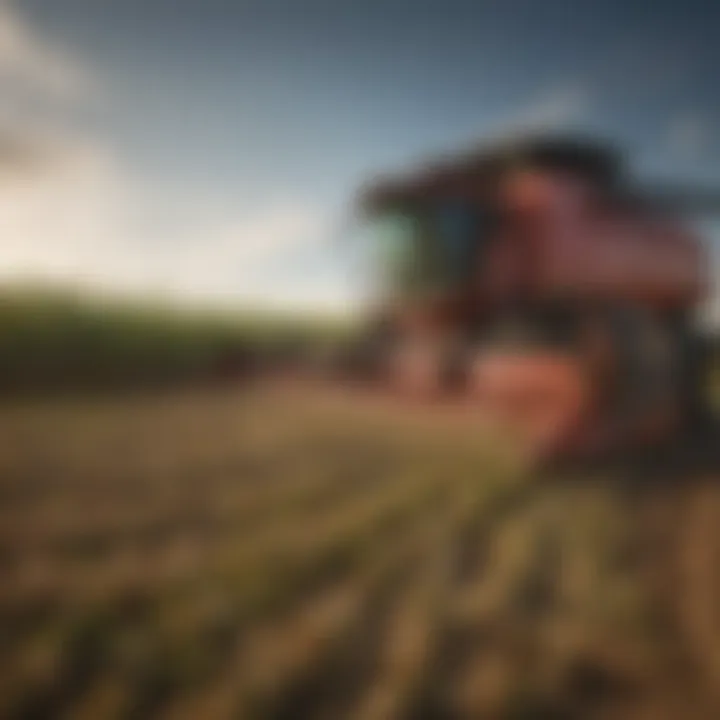Harvesting Corn: Techniques, Timing, and Best Practices


Intro
Harvesting corn requires careful planning and execution. This process is not just about collecting the crop, but also involves techniques that maximize efficiency and yield. Timing plays a crucial role in harvesting. If done too early or too late, it can significantly impact the quality and quantity of the harvest. As such, understanding the nuances of corn harvesting is vital.
Importance of Advanced Techniques
New technologies have transformed corn harvesting. For instance, modern combines equipped with GPS technology help farmers determine the best routes for efficiency. This innovation also aids in monitoring crop health throughout the growing season. Adopting these advanced methods can lead to higher yield and better resource management, which is important in today's competitive agricultural landscape.
Timing for Optimal Yield
Determining the right moment to harvest corn is essential for accomplishing the best results. The ideal time usually falls when kernels reach a certain moisture level. If moisture content is too high, it can lead to spoilage during storage. Conversely, harvesting when moisture is too low can result in kernel damage. Generally, moisture levels between 15-20% are targeted for corn harvest.
"Harvesting at the correct moisture level ensures that the kernels maintain their quality and value."
Best Practices for Sustainability
A sustainable approach to corn harvesting not only benefits environmental health but also improves economic outcomes for farmers. Some methods include cover cropping, which protects soil and improves fertility. Additionally, proper rotation of crops contributes to reducing pests and diseases, leading to healthier corn production.
Key Considerations
To summarize, there are a few essential points to remember for effective corn harvesting:
- Timing is critical: Understand and monitor the moisture content of the kernels.
- Invest in technology: Use machinery that enhances efficiency and data accuracy.
- Follow sustainable practices: This fosters the health of the ecosystem while ensuring a productive crop.
By focusing on the techniques, timing, and best practices detailed above, those involved in corn harvesting can optimize both yield and quality. This is the foundation of successful corn production.
Understanding Corn Cultivation
Corn is a staple crop, vital for both human consumption and livestock feed. Understanding its cultivation is key for maximizing yield and ensuring quality. In this article, we will detail several significant components of corn cultivation that every grain producer should comprehend. This includes the growth cycle, environmental requirements, and the diversity of corn varieties. A strong grasp of these aspects will lead to better decision making in the harvesting process.
The Growth Cycle of Corn
The growth cycle of corn involves several critical stages, beginning with planting and ending with harvest. Typically, corn reaches maturity about 90 to 120 days after planting, depending on the variety. The lifecycle can be broken down into germination, vegetative growth, flowering, and grain filling. Each phase demands specific care and attention to environmental factors such as soil moisture and temperature.
Germination occurs when seeds absorb water and begin to sprout. This stage is crucial as it sets the foundation for future growth. After germination, the vegetative stage follows, during which the plant develops leaves and stem strength. Flowering is when pollination takes place, leading to kernel formation during the grain filling stage. Knowing this cycle helps farmers determine optimal timing for harvesting.
Environmental Requirements
Corn thrives in specific environmental conditions that significantly influence yield. First, adequate sunlight is essential, as corn requires full sun for proper growth. Additionally, soil type plays a vital role; well-drained, fertile soils enriched with organic matter are preferred. The pH of the soil should ideally be between 6.0 and 6.8 to promote nutrient uptake.
Water is another crucial element. Corn needs consistent moisture throughout its growth, particularly during pollination and kernel filling. Stress from drought or excessive wet conditions can adversely affect yield. Monitoring weather patterns and soil quality is thus necessary for ensuring productive growth.
Types of Corn Varieties
Corn comes in various types, each serving distinct roles in agriculture. Below are some of the more common varieties:
Field Corn
Field corn is primarily cultivated for animal feed and industrial uses. Unlike sweet corn, which is harvested earlier for fresh consumption, field corn is allowed to mature fully. One of the key characteristics of field corn is its high starch content, making it an excellent energy source for livestock feed. Field corn's ability to produce a high yield per acre is a significant advantage for farmers, promoting economic viability. Its unique feature of being genetically modified (in many cases) for resistance to pests and drought makes it appealing, though it also raises concerns about sustainability.
Sweets Corn


Sweet corn is commonly consumed by people and is characterized by its high sugar content. This variety is harvested when immature to maintain its sweet flavor. Sweet corn is vital for the fresh market and canned products. One key characteristic of sweet corn is that it does not store well, needing quick processing after harvest. This can be a disadvantage for growers focusing on long-distance distribution but enhances its appeal for local markets and fresh consumption.
Popcorn
Popcorn is unique due to its hard outer shell and a starchy interior, which causes it to 'pop' when heated. This trait defines its primary use as a snack food. Popcorn needs specific conditions and proper moisture balance to ensure a successful harvest. While it has a smaller growing area compared to other corn types, its demand as a snack contributes significantly to the market. Popcorn's cultivation requires attention to detail and timing, especially during the harvest to avoid spoilage and maximize its unique quality.
Understanding these varieties allows farmers to make informed decisions regarding planting and harvesting, ultimately impacting market strategies and profitability.
Timing the Harvest
The timing of the harvest plays a critical role in determining the success of corn production. It not only influences the yield but also significantly impacts the quality of the corn. Getting the timing right involves several factors, including understanding the indicators of ripeness, analyzing weather conditions, and choosing the appropriate time of day for harvesting. By focusing on these aspects, farmers can maximize their output and ensure the harvested corn meets market standards.
Indicators of Ripeness
Knowing when to harvest corn is vital. A few visible signs indicate that corn is ready for harvesting. One key indicator is the moisture content of the kernels. When corn is mature, kernels should have a moisture level between 15 to 20 percent, which is ideal for storage. The husks also turn brown and dry, and the silks at the top of the ear become dark and withered.
Another important sign is the hardness of the kernels themselves. A pinch test can be done to check if the kernels are firm. If you can push into a kernel easily, it may not be ripe. Furthermore, the black layer, a small dark line at the base of the kernel, is a definitive sign that corn has reached physiological maturity.
Impact of Weather Conditions
Weather plays a significant role in deciding the timing of the corn harvest. Rain just before the harvest can increase the moisture content of the corn, making it unsuitable for immediate storage. Moreover, wet conditions can lead to more fungal infections, compromising the quality of the harvest. Therefore, farmers must monitor forecasts closely.
In contrast, drought conditions prior to harvest can lead to lower yields and smaller kernels. Ideal weather during the weeks leading up to harvesting includes sunny, dry days. Such conditions improve the quality of both the kernels and the plant itself, reducing risk of injury during the harvesting process.
Best Time of Day for Harvesting
The time of day can impact the harvesting operation. Early morning or late afternoon are often seen as the best times to harvest corn. During these hours, the temperatures are cooler, which can help reduce stress on the plants and make the kernels easier to handle. As the day heats up, the corn may take on moisture from dew, which can affect quality negatively.
Additionally, harvesting too late in the day can lead to excessive moisture accumulation. Also, operating machinery during cooler hours tends to be more efficient as it reduces engine overheating. Of course, having a well-planned schedule can make a significant difference in managing crop harvest.
Remember, timely harvesting can optimize both yield and quality which is essential for successful corn production.
Harvesting Methods
Harvesting methods are a critical component of corn production. They directly impact the quality, efficiency, and overall success of the harvest. Understanding the various techniques allows farmers to choose the most suitable approach based on their needs, goals, and available resources. The right harvesting methods can maximize yield and minimize losses during the harvest period. Manual and mechanical harvesting each offer distinct advantages and challenges that must be evaluated carefully.
Manual Harvesting Techniques
Manual harvesting involves the hand-picking of corn. This method can be labor-intensive and time-consuming, but it has its benefits. One major advantage is precision. Farmers can selectively harvest ripe ears while leaving immature ones on the stalk. This selective approach can result in better quality corn.
Moreover, manual harvesting does less damage to the plants and soil. This is especially important in small-scale or organic farming. Workers can be more careful, which helps in maintaining the integrity of the corn plants. However, this technique is not ideal for large fields due to its inefficiency and the high labor costs involved.
Mechanical Harvesting
Mechanical harvesting has gained popularity because of its speed and efficiency. Modern machinery has greatly improved the capabilities of harvesting corn. The two significant types of mechanical harvesting include combine harvesters and corn heads.
Combine Harvesters
Combine harvesters are among the most versatile equipment used in corn harvesting. They can cut, thresh, and clean the corn in a single pass, making them an efficient option for large fields. One key characteristic of combine harvesters is their ability to adapt to various conditions and crop types. They can be adjusted for different harvesting situations, which enhances their utility.
The unique feature of combine harvesters is their multi-functional design. They streamline the harvesting process and reduce the need for multiple machines. However, they require a significant investment and maintenance. Moreover, inexperienced operators may struggle to run these machines effectively, which can lead to harvest losses. Despite these drawbacks, their speed and efficiency make them a popular choice in commercial corn production.
Corn Heads


Corn heads are attachments specifically designed for combine harvesters. They play a crucial role in the mechanical harvesting process. Their primary function is to gather the corn efficiently while reducing the chances of ear loss. A key characteristic of corn heads is their design, which allows for the adjustment of row spacing. This flexibility is beneficial when harvesting different corn varieties or aligning with varying planting practices.
The unique feature of corn heads is their ability to operate in diverse field conditions. They can handle changes in terrain and even uneven fields without losing efficiency. On the downside, improper use or lack of maintenance can lead to higher wear and tear. This could increase costs over time. Nevertheless, while selecting harvesting methods, corn heads are essential for optimizing the performance of combine harvesters.
Post-Harvest Handling
Post-harvest handling is vital to maintaining the quality of the harvested corn. It includes various processes to prepare the corn for storage or sale. Good post-harvest practices can significantly reduce spoilage and improve marketability. Key considerations include drying, storage conditions, and timely transportation to ensure the corn remains in optimal shape. Proper ventilation and moisture control during this phase are critical for preventing mold and degradation.
In summary, the choice of harvesting methods—be it manual or mechanical—impacts the overall success of corn harvesting. By understanding the strengths and weaknesses of each method, farmers can make informed decisions that align with their operational goals.
Quality Control During Harvest
Quality control during corn harvest plays a pivotal role in ensuring the overall success of corn production. With the rise of competitive markets and consumer demands, being proactive about quality can yield significant benefits. It begins far before the actual harvesting process and should be an ongoing concern throughout the growth and harvesting cycle.
Harvesting can greatly impact kernel quality. A well-timed harvest prevents over-ripening, which might compromise the flavor and nutritional value of the corn. Similarly, ensuring the right moisture content at harvest aids in maintaining kernel integrity and reduces the likelihood of spoilage during storage.
Furthermore, paying close attention to quality control can help in detecting diseases or pests that may not be immediately visible. Taking measures to rectify these issues can save considerable losses.
Integrating quality control measures leads not only to better product integrity but can also enhance marketability. Higher quality corn can command premium prices, benefiting the bottom line. Thus, quality control is not just a necessary measure, but a strategic component that can facilitate greater economic returns.
Assessing Kernel Quality
Assessing kernel quality is essential for achieving expected yields and maintaining consumer satisfaction. Key indicators of kernel quality include kernel size, moisture content, and absence of defects.
- Kernel Size: Larger kernels usually indicate better growth conditions and can influence the perception of quality by buyers.
- Moisture Content: The ideal moisture range for harvested corn generally lies between 15% and 20%. This moisture content balances the risk of spoilage and the quality of the final product.
- Defects: Identifying any physical damage or signs of rot or pests ensures that only the best corn makes it to market.
Regular inspections throughout the harvesting time help monitor these variables and ensure compliance with market expectations. Special tools, such as moisture meters, assist in accurately assessing the moisture level of corn.
Avoiding Contamination
Preventing contamination during the harvesting process is crucial for maintaining the quality and safety of the corn. Several considerations help achieve this goal.
- Clean Equipment: Ensuring all harvesting machinery is clean prior to starting work protects against the transfer of harmful pathogens and chemicals.
- Proper Storage: Once harvested, corn should be stored in clean, dry facilities to minimize exposure to elements that could cause spoilage.
- Minimizing Exposure: Keeping the corn covered and protected from direct contact with external contaminants, such as soil or debris, further helps ensure quality.
"Maintaining the integrity of harvested corn ultimately contributes to a better product for consumers, translating into higher sales and reputation in the market."
Understanding the significance of quality control, assessing kernel quality, and avoiding contamination form a sequential guide to enhance the harvesting process. Through diligence and proactive measures, farmers can greatly improve both the quality and market viability of their corn.
Economics of Corn Harvesting
The economics of corn harvesting plays a significant role in agricultural productivity and sustainability. Understanding the financial implications can help farmers make informed decisions that affect not just their operations, but also the broader agricultural market. This section provides insights into the cost of harvesting corn and the current market trends that influence pricing.
Cost Analysis of Harvesting
Cost analysis is critical for farmers when planning their corn harvesting operations. Various factors contribute to the overall cost, which can vary from one farm to another. Some of these factors include:
- Labor Costs: Labor expenses can be substantial. Whether employing seasonal workers or utilizing family labor, it factors significantly into total expenses.
- Equipment Expenses: Farmers need suitable machinery for efficient corn harvesting. This can involve expenses for purchasing, leasing, or maintaining combine harvesters and corn heads.
- Fuel and Maintenance: Operating machinery requires energy, often in the form of diesel fuel. Maintenance also adds to long-term costs, as regular servicing is essential to ensure the equipment's longevity.
- Post-Harvest Handling: Proper handling influences the overall quality of corn and incurs additional costs. This includes transportation, drying, and storage facilities, all of which have financial implications.
Evaluating these elements allows farmers to create a budget that directly impacts profitability and return on investment. Understanding how each cost component contributes to total harvesting costs is essential in assessing whether to invest in new technologies or strategies.
Market Trends and Pricing
Market trends and pricing are critical in the economic landscape of corn harvesting. The following aspects are crucial for consideration:


- Supply and Demand: The basic principle of supply and demand heavily influences corn prices. A high demand for corn, possibly driven by the food or ethanol industries, can lead to increased prices.
- Climate Conditions: Weather events can impact harvest yields and, subsequently, market prices. For example, a drought might reduce supply, causing prices to rise, while a bountiful harvest could lower prices.
- Global Trade Factors: International markets are interconnected. Changes in trade policies, tariffs, or demand in other countries can necessitate adjustments in local pricing strategies.
- Technological Innovations: New harvesting technologies can lead to greater efficiency and lower costs over time. As farmers adopt these technologies, market dynamics may shift, impacting pricing and competition.
"Understanding the economic aspects of corn harvesting is essential for maximizing profit margins and ensuring sustainability in today’s competitive market."
Navigating the economics of corn harvesting requires continuous monitoring of these trends. Farmers should remain informed about market conditions, adapting their strategies accordingly to improve profitability while ensuring sustainable practices.
Sustainable Practices in Corn Harvesting
Sustainable practices in corn harvesting are crucial for ensuring not only the health of the crop but also that of the environment. Sustainable methods promote a balance between agricultural productivity and the stewardship of natural resources. These practices are driven by the need to minimize negative impacts on ecosystems while maximizing yield and quality. As environmental concerns grow, it has become increasingly important for farmers to adopt harvesting techniques that protect soil health and promote biodiversity.
Minimizing Soil Erosion
Soil erosion remains a significant issue in agriculture, particularly in intensive corn production. When soil erosion occurs, valuable topsoil is lost, along with nutrients needed for optimal crop growth. This leads to decreased fertility and can result in lower yields over time. Methods to minimize soil erosion include planting cover crops, which protect the soil from wind and water erosion during off-seasons.
Additionally, contour farming, where crops are planted across the slope of the land, helps slow water runoff and reduces soil loss. Implementing no-till or reduced-till practices also preserves soil structure and promotes moisture retention. These methods can greatly enhance soil quality and lead to sustainable corn growth.
Crop Rotation Benefits
Crop rotation is another essential sustainable practice in corn harvesting. By alternating the types of crops grown in a particular field, farmers can disrupt cycles of pests and diseases that affect corn. Certain crops, like legumes, can also enrich the soil by fixing nitrogen, a critical nutrient for corn production.
Benefits of crop rotation include:
- Improved soil structure: Different root systems contribute to healthier soil hierarchies.
- Pest and weed management: Rotating crops helps break the life cycle of specific pests, reducing the need for chemical interventions.
- Increased biodiversity: Bringing a variety of crops into the farming system supports a wider range of insects and wildlife.
"Adopting sustainable harvesting practices not only benefits the current crop yield but ensures the agricultural viability for generations to come."
For further reading on sustainable practices in farming, visit Wikipedia and Britannica.
Future Trends in Corn Harvesting
The landscape of corn harvesting is evolving continuously. Modern farmers must adapt to changing technologies, environmental factors, and market demands. Understanding future trends is essential for maximizing yield and quality. This section focuses on two main components: technological innovations and global harvesting practices. Each element plays a significant role in shaping the future of corn harvesting. Awareness of these trends can help farmers and stakeholders make informed decisions about their practices.
Technological Innovations
Emerging technologies are redefining the corn harvesting process. Innovations such as precision agriculture are allowing farmers to optimize their operations. With the aid of drones and satellite imagery, farmers can monitor crop health and soil conditions accurately. These technologies enable more precise applications of inputs, reducing waste and enhancing sustainability.
Additionally, advances in automated machinery are significant. For example, self-driving combine harvesters are now entering the market. These machines can operate independently, which lowers labor costs and increases operational efficiency. They also gather valuable data during the harvesting process, providing insights for future planning.
Moreover, data analytics plays a crucial role. Farmers can utilize data to predict weather patterns and adjust their harvesting schedules accordingly. The integration of Internet of Things (IoT) devices can further enhance efficiency. Sensors placed throughout fields can provide real-time information about moisture levels, enabling timely harvesting to prevent losses due to spoilage.
Global Harvesting Practices
The approach to corn harvesting varies significantly between countries, particularly when comparing developed and developing nations.
Developed vs. Developing Countries
In developed countries like the United States and Canada, corn harvesting utilizes highly mechanized systems. Farmers rely on advanced machinery such as high-capacity combine harvesters. This leads to efficient harvesting but also generally higher initial costs. The infrastructure further supports these operations, ensuring ease of transporting harvested corn to storage facilities.
Conversely, in developing countries, corn harvesting often involves more manual labor. While this can be seen as less efficient, it allows for local employment opportunities. Traditional techniques may be combined with modern practices as technology becomes more accessible. An important characteristic of developing countries is the need for sustainable improvements. This means adopting practices that are affordable and environmentally friendly.
This contrasts with the rapid mechanization seen in developed nations, which can lead to soil depletion if not managed properly. The different approaches highlight the balance that needs to be struck between technology adoption and maintaining ecological integrity.
Cultural Varieties of Corn
The diversity of corn varieties reflects local agricultural practices. In different regions, unique types of corn are cultivated. For instance, flint corn is popular in parts of Africa due to its resistance to drought. In contrast, dent corn thrives in the United States and is used heavily in animal feed and industrial products.
Each cultural variety presents distinct advantages and disadvantages. Specific local conditions dictate which corn type is most suitable, resulting in varying harvest techniques. Understanding these varieties allows farmers to choose the best crops tailored to their environment. For instance, utilizing native varieties can enhance resilience against local pests and diseases.
Understanding the interplay between technology and local practices is vital for the future of corn harvesting. As farmers globally refine their methods, adapting to both innovation and tradition will lead to sustainable practices.







